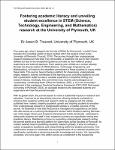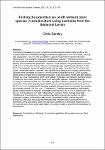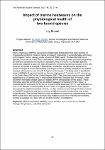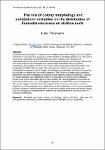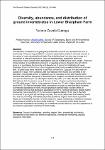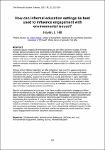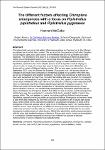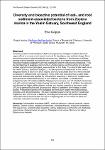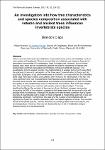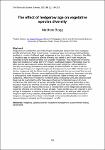The Plymouth Student Scientist - Volume 16, No.2 - 2023
Table of contents for this edition
These incredible research and development articles in this edition are from STEM students at the University of Plymouth, working on their final year research projects . A huge thank you to them, and their committed supervisors. I have enjoyed reading your submissions and working with you all. With kind regards, Dr Jason B. Truscott (Chief Editor).
Editorial
Jason B. Truscott, Fostering academic literacy and unveiling student excellence in STEM (Science, Technology, Engineering, and Mathematics) research at the University of Plymouth, UK, pp. i-v.
Biological and Marine Sciences:
Jonathan Bailey, Why are some beaches more conducive to surfing? Bathymetric effects on nearshore waves at Croyde, pp. 1-26.
Lily Burnet, Impact of marine heatwaves on the physiological health of two fucoid species, pp. 27-43.
Ellie Hawcutt, Bat activity and diversity in Plymouth’s green spaces: Implications for future conservation and management, pp. 44-68.
Keira N. Lintin, Assessing the spatial and temporal distribution of microplastics within the sediment of Plymouth Sound, pp. 69-93.
Luke Thompson, The role of colony morphology and substratum inclination on the distribution of Eunicella verrucosa on shallow reefs, pp. 94-109.
Amy Wick, Evaluating to what extent the ‘scientific exemption clause’ acts as a loophole and influences international whaling, pp. 110-131.
Biomedical Sciences:
Eva Capps, Diversity and bioactive potential of leaf-, and root sediment-associated bacteria from Zostera marina in the Yealm Estuary, Southwest England, pp. 132-156.
Engineering, Computing and Mathematics:
Ava Keeling and Paula Oben, A statistical analysis of the population of Barbel in the River Teme, pp. 157-174.
Geography, Earth and Environmental Sciences:
Olivia Bentley, Testing the potential use of UK wetland plant species in paludiculture using examples from the Somerset Levels, pp. 175-198.
Matthew Blogg, The effect of hedgerow age on vegetative species diversity, pp. 199-223.
Brandon Clapp, An investigation into how tree characteristics and species composition associated with veteran and ancient trees influences invertebrate species, pp. 224-252.
Hayley L. Hill, How can informal education settings be best used to influence engagement with environmental issues?, pp. 253-284.
Hannah McCabe, The different factors affecting Chiroptera emergences with a focus on Pipistrellus pipistrellus and Pipistrellus pygmaeus , pp. 285-313.
Valeria Zavala Quiroga, Diversity, abundance, and distribution of ground invertebrates in Lower Sharpham Farm , pp. 314-346.
Psychology:
Lucy Olivia Wilson, Are human-like robots trusted like humans? An investigation into the effect of anthropomorphism on trust in robots measured by expected value as reflected by feedback related negativity and P300, pp. 347-376.
Recent Submissions
-
Fostering academic literacy and unveiling student excellence in STEM (Science, Technology, Engineering, and Mathematics) research at the University of Plymouth, UK
(University of Plymouth, 2023)Six years ago, when I stepped into the role of Editor for this journal, I couldn't have foreseen the incredible wealth of talent nestled within the student cohort at the University of Plymouth (Truscott, 2018). The journey ... -
Testing the potential use of UK wetland plant species in paludiculture using examples from the Somerset Levels
(University of Plymouth, 2023)The trade-off between economic benefits and environmental sustainability results in the unsustainable use of wetlands through conversion to agricultural land. As a result, causing peat degradation, reducing the ecosystem’s ... -
Impact of marine heatwaves on the physiological health of two fucoid species
(University of Plymouth, 2023)Marine Heatwaves (MHWs) are periods of high-water temperature that have become an increasingly significant threat to marine ecosystem biodiversity in recent decades with rising anthropogenic carbon driving greater severity ... -
The role of colony morphology and substratum inclination on the distribution of Eunicella verrucosa on shallow reefs
(University of Plymouth, 2023)Eunicella verrucosa plays an important role in shallow reefs, where they produce a complex 'sheet tree' morphology that supports a variety of benthic-dwelling organisms. E. verrucosa is considered 'vulnerable' by the IUCN ... -
Diversity, abundance, and distribution of ground invertebrates in Lower Sharpham Farm
(University of Plymouth, 2023)Invertebrates constitute the largest group of animals on Earth and represent the bulk of biodiversity. They are responsible for numerous essential ecosystems services and are at the centre of many terrestrial food webs. ... -
How can informal education settings be best used to influence engagement with environmental issues?
(University of Plymouth, 2023)Increasing global impacts of environmental issues will affect children’s futures. Formal primary school curriculums are insufficient in providing the information children need to understand these issues which increases ... -
The different factors affecting Chiroptera emergences with a focus on Pipistrellus pipistrellus and Pipistrellus pygmaeus
(University of Plymouth, 2023)Chiroptera (bats) are important within different ecosystems and biomes due to the different ecosystem services that they provide. The services that they provide to the United Kingdom include organic agricultural pest ... -
Diversity and bioactive potential of leaf-, and root sediment-associated bacteria from Zostera marina in the Yealm Estuary, Southwest England
(University of Plymouth, 2023)Increasing antimicrobial resistance (AMR) among human pathogenic bacteria demands urgent efforts to uncover novel natural products for developing new antibiotic drugs. Since terrestrial sources of natural products are ... -
An investigation into how tree characteristics and species composition associated with veteran and ancient trees influences invertebrate species
(University of Plymouth, 2023)Veteran and ancient trees have distinctive characteristics that act as microhabitats: such as tree cavities and deadwood. These trees and their microhabitats are keystone features for specialised communities of invertebrates, ... -
The effect of hedgerow age on vegetative species diversity
(University of Plymouth, 2023)Hedgerows are a distinctive part of the English countryside and provide many ecological benefits and services. Over recent history, hedgerows have been removed and replanted, resulting in a matrix of different aged hedgerows ...


